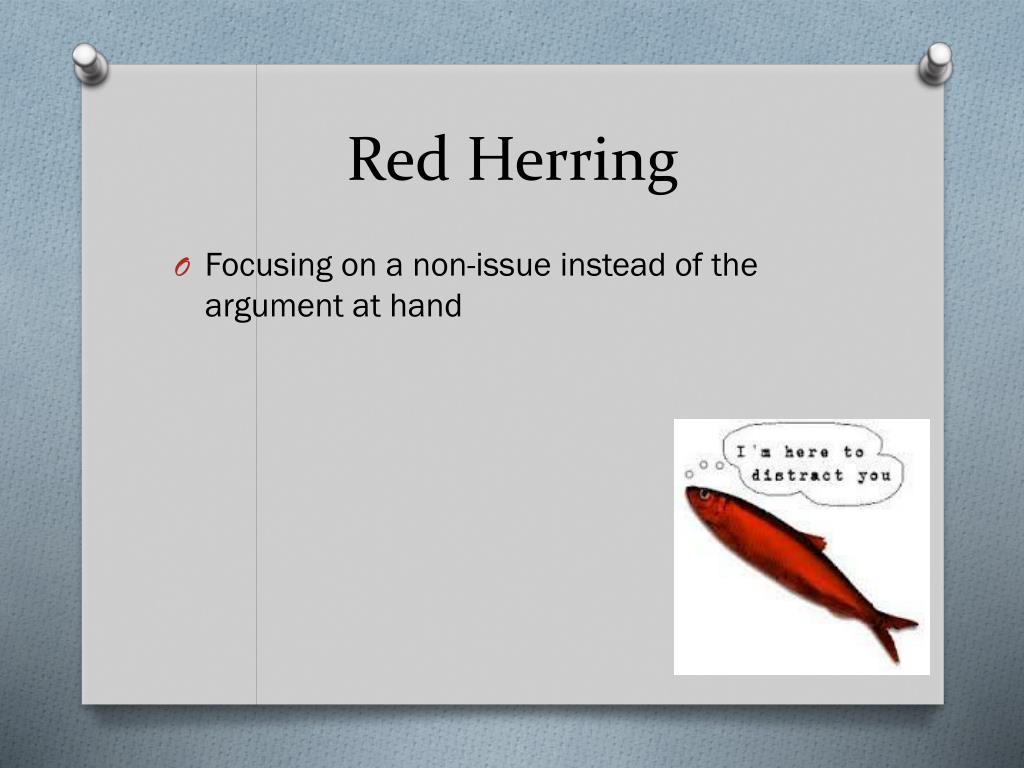


If you ask your spouse why they went clothes shopping when you had agreed on a budget, and he defends himself by saying that the clothes were on sale, he has used a red herring. A mother who tells her child to think about the children starving in Africa when he is upset because a friend hurt his feelings has thrown a red herring into the discussion. When a politician says that people are too fat to get out and vote, he distracts his audience from a legitimate question over whether registered voters have been disenfranchised. Before the true killer is revealed, most of the clues in the mystery come together in a pattern that leads to him however, a red herring stands out as a false clue, one that goes nowhere and may never fit into a larger pattern. In order to create suspense, the writer deliberately plants clues that lead her readers to suspect that an innocent character is really the killer. In fact, red herrings are a convention of this genre. The literary genre that contains the most red herrings is mystery writing. How Do You Identify a Red Herring in Writing? They are referred to as “trolls” because they troll for attention by trying to distract people from their original conversation, often by engaging in personal attack. The term originated in the early nineteenth century, when people opposed to fox hunting would drag a red herring along a course into order to throw the hounds off the scent. Nowadays, there is a special term for Internet users who like to interrupt online forum discussions by throwing out red herrings. Red herrings are also a popular strategy in political arguments.
Example of red herring logical fallacy full#
For instance, if your mother tells you to clean your room, and you respond by showing her a website full of drawings that you like, you are hoping to avoid the chore. By attacking the concept of slippery slope arguments you can show that they are often fallacious.A red herring is a logical fallacy in which someone deliberately introduces an irrelevant subject or topic to throw an argument off course or divert people’s attention.

In these instances, use an example that demonstrates the problem with slippery slope arguments in general (e.g., by using statements to reach a conclusion that is not necessarily relevant to the initial statement). Sometimes people commit a slippery slope fallacy unintentionally.Every proposition has to be true for the overall argument to work, so even if one link is irrational or not supported by evidence, then the argument collapses. Ask yourself if each link in the chain of events or action is valid.You can point out these missing steps and ask your partner to indicate what evidence exists to support the claimed relationship between two or more events. Slippery slope arguments take advantage of the gray area between an initial action or decision and the possible next steps that might lead to the undesirable outcome.There are a number of ways you can deal with slippery slope arguments especially when you suspect these are fallacious: The planning fallacy: Underestimating the time needed to complete a future task, even when we know that similar tasks in the past have taken longer than planned.The base-rate fallacy: Ignoring base-rate or statistically significant information, such as sample size or the relative frequency of an event, in favor of less relevant information e.g., pertaining to a single case, or a small number of cases.The sunk cost fallacy: Following through on a project or decision because we have already invested time, effort, or money into it, even if the current costs outweigh the benefits.Ecological fallacy: Making inferences about the nature of individuals based on aggregate data for the group.Correlation/causation fallacy: Claiming that two events that occur together have a cause-and-effect relationship even though this can’t be proven.Common types of fallacy that may compromise the quality of your research are: A fallacy is a mistaken belief, particularly one based on unsound arguments or one that lacks the evidence to support it.


 0 kommentar(er)
0 kommentar(er)
